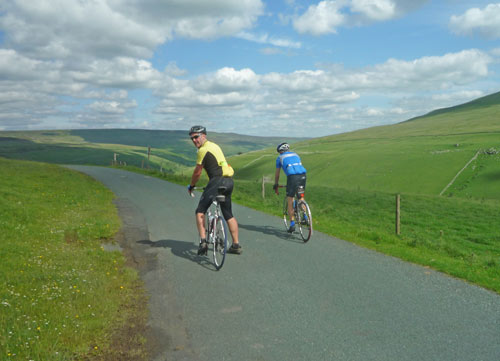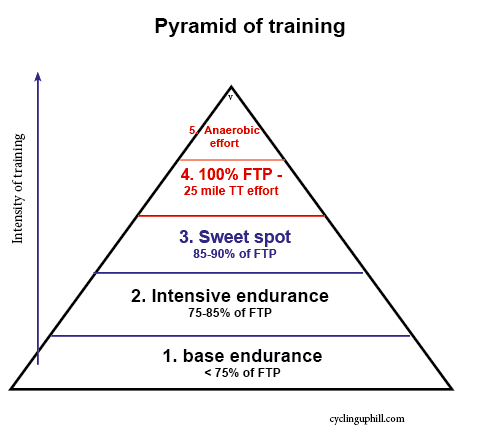Readers Question: I’m a commuter/leisure cyclist and I’m looking to getting into race fitness for a few sportives next year. I’ve never raced before and would like to know the best training methods to start increasing my fitness and speed. When I go out for a ride it’s usually only 20 miles and I ride just under my threshold to average 17mph. What should I do to start seeing that go up? I’m also going to start longer routes. Looking forward to your insight.
I remember when I started getting into cycling (quite a few years ago, I forget the number) every ride was just below at threshold, and I was obsessed with average speed. It was in the days before heart rate monitors and power meters. The only thing you had on your bike was speed, time, distance and average speed. I remember my first ever ride with a speedometer. Menston to Burnsall and back – average speed 13.5mph. Every time I went out, I always tried to get higher average speeds for my usual routes. I remember being very happy when I averaged 18 mph for a 35 mile ride from Menston to Burnsall and back.
Training for higher average speed
When you’re just beginning to cycle, any kind of cycling will make you stronger and faster – the more you cycle you will see quite a quick increase in fitness. But, after a certain point, it becomes progressively harder to increase average speed.
If you’ve just done a few 20 mile rides, there is scope for some significant improvements in fitness and speed. Some tips which spring to mind.
- Pyramid of Training
The pyramid of training basically states the majority of our training is endurance and steady work. This provides the base endurance, muscular strength and general conditions.
I quite like this model of pyramid training. It’s a good rough guide for those getting into cycling. You have a base of endurance riding – steady miles, increasing aerobic capacity and building length strength. The intensive endurance would correspond to the riding your doing just below threshold. The only comment I’d make about this pyramid, is that if time is short, cut out some of the base endurance. The most efficient way to improve cycling fitness is cycling at close to threshold. But, a mixture of endurance, threshold and intervals is important for any training plan.
- Variation in distance. 20 miles is a good distance to get started, but for cyclo sportives you can be looking at much higher distances of 100 miles plus. To enjoy riding them, you want to try and make time to get some good 3-4 hour rides in. On these rides, don’t worry about average speed to start off with. The first time you cycle for four hours, you won’t be able to do it at just below threshold! If you can do this kind of ride once a week, that is ideal, but even twice a month, will give you the capacity to make reasonable efforts in sportives next year.
- Build up aerobic base. Over winter, I would concentrate on building up mileage – either steady base miles on the longer 2-4 hour rides or just below threshold rides that you are currently doing. These won’t particularly increase your average speed, but it will give a good base to work from in the spring and give you the capacity to finish the distance. If you do race intervals with no base level, it will be harder to maximise gains from them.
- Intervals. With a greater aerobic base, you can start to think of some higher intensity efforts. Spring is psychologically a good time to start doing this, though there’s no hard and fast rule if you’re really motivated. These kind of intervals will push you into an uncomfortable zone, but give big performance improvements. For a beginner, they don’t have to be do scientific – just riding hard up hills – try timing yourself and try keep beating times. Start off with a small number of intervals and. as you become stronger, you can increase the number of intervals you do in a session. These intervals and training at close to your anaerobic threshold will do the most to increase your average speed. more on intervals
- Ten mile time trial. Another way of stretching yourself is to consider having a go at a ten mile time trial. You can do it on your own or look for one of the local club events – they usually cost about £2. A ten mile time trial is a simple test of riding at your race threshold for 30 minutes. It will help make big improvements in fitness and speed. It will also give you some motivation to try and go faster. See: 10 mile time trials
Non-fitness related ways to increase average speed
Apart from increasing your fitness, there are other more sneaky ways to increase average speed.
- Aerodynamics. Aerodynamics makes a huge difference in cycling– you don’t have to go into a wind tunnel. But, look at easy ways to reduce air drag
- A slightly lower back position, dropping handlebar position so you are lower down
- choosing closer fitting clothes. Getting rid of flapping clothes will make big difference.
- even shaving legs, does make a real difference
- How you ride. If you ride with arms flailing around and head stuck up, you will put more surface area into the wind. riding with arms tucked in and hands in middle of handlebars / drops will help a lot. If your going into strong headwind, get on the drops and keep your head low.
- Aero helmet may not look great, but helmets do make a notable difference to aero drag.
- Aero bike with deep section wheels can make a big difference to average speed.
- See: Improving aerodynamics whilst cycling
- Riding in group. Riding behind another rider, will save 20-30% of your energy and enable higher average speeds of 1-2 mph (unless you have to stop for a puncture someone has in a group.
- Reducing weight. One rough rule of thumb for every 1kg you lose, you will be 2 seconds quicker per 100m height gain. Lose 10 kg on a ride with 1,000m of climbing and you’ve saved 100 + seconds. It may not sound a lot, but it will do wonders for your average speed. Some weight saving can be relatively cheap – carbon stem, carbon saddle post e.t.c – some can become very expensive. Losing weight from excess fat usually offers biggest scope for cheap weight savings.
- Learn to corner effectively. A pro cyclist will learn to eke out every possible second. Learn to feather the brakes, rather than slam them on. Try to keep as much momentum as possible. Take a good line through the corner, though never sacrifice safety for cutting corners.
- Optimal PSI for tyres – Make sure tyres are inflated to decent level of around 90-100 PSI depending on conditions.
- Tyres with better rolling resistance – There’s always a trade off between puncture protection and speed. Ride on a heavy tyre like an Armadillo and you will hardly get a puncture, but it does slow you down. If you count puncture stops in your average speed, consider tubeless. It’s out of fashion, but tubulars are still used by racers who want to maximise speed.
- Efficient cycling – learn to pedal with minimal effort – e.g. a few situps can improve your ‘core strength’ – helping you to maintain a more stable position on your bike. If you look at pros (apart from Tommy Voeckler) they will have great poise on their bike. They reduce all movement apart from pedalling. A beginner often looks to be fighting their bike, using unnecessary upper body movements.
- Use gears for optimal cadence. Don’t force big gears, especially early in a ride. keeping a nice constant cadence, slows down muscle fatigue.
- Good energy levels. It’s easy for a beginner to make simple mistakes regarding nutrition. Half the battle on longer sportives is to remain properly fuelled and hydrated. see: cycling nutrition tips
- Make slightly more effort up hills and into headwinds. Aerodynamic drag is relatively lower at low speeds, so increased effort has a bigger impact on speed than at higher speeds.
- Learn to pace yourself well. This will be important when you do longer distance sportives. If you’re not used to the mileage, it’s easy to go off too quick and end up blowing up – leaving you to grovel around the course. A power meter can be useful for learning about pacing.
Related



Hi.
I really like this post! Your writing style, knowledge and application is awesome. I’d love to share it on my blog.
Would that be okay? Of course I’ll make a full reference to your website with a link to this post.
Can’t wait to hear back
Coach Gethin Rhys James
It is OK, with link back to post.
HI there, thanks for article.
was wondering for a bog standard cat 4/3 crit do you think an average solo speed of 19mph over 20ish miles would cut the mustard as a pack participant? I’ve not raced before so just seeing if worth me taking part or if will be spat out in the first kilo!
see the speeds of our local crits easily average 24-26mph but i don’t know how much drafting helps
thanks
Hi,
I’m 66 and only started cycling at 59. I’m fairly fit and I recently did a solo 30 mile round trip (it wasn’t a TT, there were traiffic lights etc), with an avg speed of 18.5mph. I did this on a 5oT/11T Merida Scultura. It was a right struggle and I was knackered for days afterwards. My question is; If I change to a 52T would I get any more speed up?
Not really. Possibly a little faster on the downhills. But, your average speed would probably end up being the same.